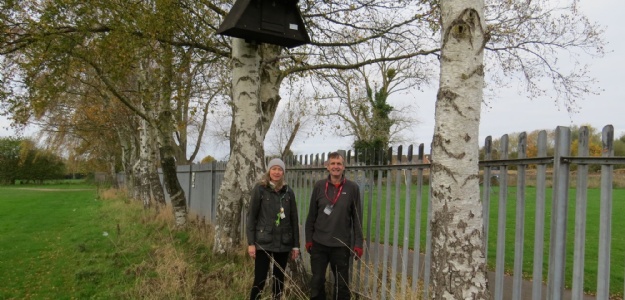Barn owls welcomed by WNAT school

Birds large and small are being welcomed to a WNAT school, with the installation of a range of nesting boxes – including one especially designed for barn owls.
The Environment Society at Springwood High School in King’s Lynn worked with the Hawk and Owl Trust to determine the suitability and placement of the Owl Box, which has been positioned along the edge of the school’s playing field.
“Following a favourable survey of the school grounds, Simon Dudhill from Sculthorpe’s Hawk and Owl Trust commissioned and personally installed the box,” said Agnieszka Munns, who is Environment Lead at the school.
“One boundary of Springwood High School’s playing fields borders the Gaywood River floodplain, which is a perfect hunting ground for birds of prey such as kestrels, common buzzards, red kites and barn owls. It is hoped that this adjacent area will make the nest box attractive to a pair of barn owls.
“Such boxes are important as, according to the RSPB, almost half the UK’s population of barn owls now nest inside them.”
“As well as providing a talking point and inspiration for pupils, the nest is visible to members of the public who are using the footpath that parallels the school boundary,” she continued. “It is possible that this path may cause levels of disturbance that will dissuade barn owls from using the nest.
“Nevertheless, even if this turns out to be the case, it is hoped that other, less shy species – like kestrels or stock doves – may take up residence in the box.”
The Owl Box is one of a range of bird boxes which the school has been introducing into the grounds, with the others hand made by students from Springwood’s Design and Technology Club, led by Teacher Adam Sedgley.
“Springwood High School supports the eco idea of rewilding its generous site, thereby increasing its biodiversity, and encouraging native wildlife to share the area with its staff and pupils,” added Mrs Munn.
“The different nesting boxes will provide smaller native birds with cosy homes. One of the most significant causes of wildlife decline is a lack of suitable habitat for breeding. By providing bird boxes and nest sites – together with improved, wilder, set-aside areas to encourage insects for birds to feed on – the school is trying to make its grounds more attractive for birds, many of whom will be seeing their local area being increasingly urbanised.
“The Headteacher of Springwood, Andy Johnson, has gone as far as to joke that sea eagles – white-tailed eagles – will soon be nesting on the school boundary!”
